This article was medically reviewed by Sarah Gehrke, RN, MS. Sarah Gehrke is a Registered Nurse and Licensed Massage Therapist in Texas. Sarah has over 10 years of experience teaching and practicing phlebotomy and intravenous (IV) therapy using physical, psychological, and emotional support. She received her Massage Therapist License from the Amarillo Massage Therapy Institute in 2008 and a M.S. in Nursing from the University of Phoenix in 2013.
wikiHow marks an article as reader-approved once it receives enough positive feedback. In this case, several readers have written to tell us that this article was helpful to them, earning it our reader-approved status.
This article has been viewed 1,245,295 times.
Most moles are not dangerous, but they can be unsightly and make you feel self-conscious. They are pigmented cells on the skin that can appear in clusters or alone. Moles can be tan, dark brown, black, or even have a yellow tint or are skin colored.[1] Whether you're willing to go down the surgical route, or prefer to treat your mole at home, most moles are relatively easy to remove. The best option is to see a doctor for safe, effective mole removal. If you're eager to get rid of an unwanted mole as quickly as possible, here are some practical steps you can take.
Steps
Using Surgical Treatments
-
1Consult your doctor or dermatologist. You should have your mole examined by a doctor or dermatologist before you get it removed. They will be able to tell you whether your mole is malignant. They will also discuss what mole removal method is best for you.
- The vast majority of moles are benign. However, symptoms including itchiness, bleeding and changes in size or color may indicate that the mole is malignant.[2]
- If a mole is malignant, it should be removed as soon as possible.
- If your mole is not dangerous, it may not be necessary to have it removed. However, many people prefer to have their moles removed for aesthetic reasons.
- Your doctor will use the ABCDE guide to assess your mole. This stands for Asymmetry, Border, Color, Diameter, and Evolving.[3]
-
2Weigh up your options. There are several methods of removing moles and you should carefully consider which method is best for you. You will need to think about:
- Effectiveness. Consider how effective each treatment is supposed to be. Will your chosen procedure remove the mole completely? Is there a risk that it could grow back?
- Cost. Different procedures will vary in terms of price, so think about what you can afford.
- Risk. What are the risks associated with each procedure? Can the mole become infected? Is there a risk of scarring or nerve damage? Will you need to be put under anesthetic?
Advertisement -
3Consider removal using shaving. This type of removal works best for surface level moles. The mole is shaved off with a scalpel.[4]
- First, the surgeon will cut the mole away, so it no longer forms a bump on the skin.
- With this type of removal, stitches are unnecessary. The wound will be cauterized or covered in a cream or solution to stop the bleeding. Then a topical antibiotic will be applied.
- The wound will be bandaged up and you'll be free to leave the office in a matter of minutes.[5]
-
4Consider removal using an excision followed by stitches. This type of removal works best for moles that are darker in color or flat moles that penetrate deep within the skin.
- First, the mole and surrounding skin will be sterilized and numbed.
- Then, the surgeon uses a scalpel to cut out the mole. How deep of an incision needs to be made will depend on the size of the mole and whether or not it's malign. A wider area is usually cut away when the mole is malign, to ensure it is removed completely.
- The wound is then stitched closed. Some types of stitches require a follow-up appointment to be removed, while others will dissolve on their own.[5]
-
5Consider removal using cryosurgery, or freezing. This is an alternate mole removal method which uses liquid nitrogen to freeze and destroy the mole. It is only offered by certain clinics. Also, keep in mind that cryotherapy freezes the tissue, so there would not be any tissue available to send a lab for testing and you would not be able to find out if the mole is cancerous.
- The liquid nitrogen can be applied to the mole directly using a cotton swab, or may be applied in the form of a spray.
- The liquid nitrogen may need to be applied several times to completely get rid of the mole. It will cause a blister to form on the skin, but once this heals, the skin should return to normal.
-
6Consider removal using electrocoagulation, or burning. Electrocoagulation burns the mole by shocking it with an electric current. This destroys the mole's tissue after several sessions. There is no need for stitches with this method, as the heat from the electricity cauterizes the wound. With this procedure, there would also be no tissue to send to a lab for cancer testing.
- Two other specialized mole removal methods offered by some clinics are radiosurgery, which uses radio frequency waves rather than electricity, and laser treatments. Both of these work on the same idea of burning the mole tissue away.
-
7Ask your doctor about electrosurgery. Electrosurgery may be a good option to discuss with your doctor. Using electrosurgery for mole removal can reduce any bleeding that may occur, and this in turn will reduce the risk of complications, promote rapid wound healing, and result in minimal scarring.[6]
Using Home Remedies
-
1Apply aloe vera. Aloe vera may be useful as a remedy for skin conditions, such as psoriasis, cold sores, burns, and frostbite.[7] Applying aloe vera to your mole daily may help to get rid of it. To use aloe vera for mole removal, apply a generous amount of aloe vera to your mole, and then cover the mole with a clean cotton bandage. Leave the bandage on for three hours, and then remove it and wash away the aloe. Do this every day for three weeks and you may see results.
-
2Test out apple cider vinegar. Apple cider vinegar - a miracle ingredient used in countless home remedies - is one of the most common treatments for mole removal. The acids contained in the vinegar, such as malic and tartaric acid, actually work to dissolve the mole, completely removing it from the skin. Simply swab a little onto clean skin everyday using a q-tip.
-
3Know that garlic might be effective. Garlic is another multi-purpose remedy, which many claim as an effective treatment for mole removal. Simply crush some fresh garlic into a paste and carefully apply directly to the mole, making sure to avoid the surrounding skin (garlic can burn). Cover with a bandage and leave for a few hours or overnight. This method has been said to work in as little as five days.
-
4Use iodine. Iodine is a good option for people with more sensitive skin, as it won't burn like garlic or apple cider vinegar. Apply the iodine directly to the mole using a q-tip, up to three times a day. Continue to do this every day, until you see a noticeable improvement in the mole's appearance.
-
5Try sour apple juice. Juice a couple of sour cooking apples and apply a little juice directly to the mole. Like the apple cider vinegar, the acids in the juice will work to dissolve the mole, though it may be at least three weeks before you start to notice any improvements in the mole's appearance.
-
6Prep with pineapple and sea salt. Pineapple juice can be applied directly to the mole, but you should also try blending half a cup of fresh pineapple and a quarter cup of coarse sea salt to make a fantastic facial scrub. This may help to remove the top layers of skin from the mole.
-
7Test out castor oil and baking soda. Combine one tablespoon of baking soda and two tablespoons of castor oil make a paste. Apply a little directly to your mole and leave for several hours or overnight, before washing off.
-
8Try using honey. Honey is well-known as a delicious edible treat, but did you know it also boasts impressive anti-bacterial and healing properties? Dab a little honey directly onto the mole for a safe, natural treatment. Add in a drop of soothing, softening flaxseed oil too, if you like.
-
9Use home remedies responsibly. There are numerous home remedies designed to get rid of moles using natural ingredients. Though there is little science to back up some of the treatments, many people will attest to their effectiveness. Just be careful when using acidic natural juices, which have the potential to burn the skin. To use home remedies safely but effectively, apply the natural juices at least once and a maximum of three times a day.
- If you have very sensitive skin, only let the juices sit on your skin for 10 to 15 minutes, to prevent it from becoming irritated.
- Try applying a little petroleum jelly to the skin around the mole. This will prevent it from becoming unnecessarily irritated by the mole treatments.
- The length of time it takes for a mole to lighten or disappear will differ from one person to another.
- Be aware that home remedies are not likely to work as quickly or be as effective as surgical removal or stronger medical creams, but are a good option if you are looking for either a cost-free solution or a natural remedy.
Using Medicated Creams
-
1Try using mole removal cream. Mole removal creams are an affordable and fairly effective method of removing moles at home.
- Most creams work by lightening the mole until it is no longer visible, which can happen in a matter of weeks.
- Stronger, over-the-counter creams focus on peeling the skin away layer by layer until the mole is removed.
- Keep in mind that mole removal creams can actually leave worse scars than surgical removal.[8]
-
2Try out whitening cream. A general-use whitening cream can also be effective at reducing the appearance of moles, but it will no actually remove the mole. A whitening cream will lighten the color of your mole, making it less obvious.
Expert Q&A
Did you know you can get expert answers for this article?
Unlock expert answers by supporting wikiHow
-
QuestionHow can I remove a flat mole?
 Sarah Gehrke, RN, MSSarah Gehrke is a Registered Nurse and Licensed Massage Therapist in Texas. Sarah has over 10 years of experience teaching and practicing phlebotomy and intravenous (IV) therapy using physical, psychological, and emotional support. She received her Massage Therapist License from the Amarillo Massage Therapy Institute in 2008 and a M.S. in Nursing from the University of Phoenix in 2013.
Sarah Gehrke, RN, MSSarah Gehrke is a Registered Nurse and Licensed Massage Therapist in Texas. Sarah has over 10 years of experience teaching and practicing phlebotomy and intravenous (IV) therapy using physical, psychological, and emotional support. She received her Massage Therapist License from the Amarillo Massage Therapy Institute in 2008 and a M.S. in Nursing from the University of Phoenix in 2013.
Registered Nurse Any mole, including a flat mole, on the face should be looked at by your dermatologist. Home remedies are unverified, may take several weeks, and may cause more scarring than a procedure done by a medical professional. Treating moles at home on your face can be difficult without leaving scars behind.
Any mole, including a flat mole, on the face should be looked at by your dermatologist. Home remedies are unverified, may take several weeks, and may cause more scarring than a procedure done by a medical professional. Treating moles at home on your face can be difficult without leaving scars behind. -
QuestionI cut the skin surrounding my mole by accident while trying to remove a mole. How can I help the area heal quickly?
 Sarah Gehrke, RN, MSSarah Gehrke is a Registered Nurse and Licensed Massage Therapist in Texas. Sarah has over 10 years of experience teaching and practicing phlebotomy and intravenous (IV) therapy using physical, psychological, and emotional support. She received her Massage Therapist License from the Amarillo Massage Therapy Institute in 2008 and a M.S. in Nursing from the University of Phoenix in 2013.
Sarah Gehrke, RN, MSSarah Gehrke is a Registered Nurse and Licensed Massage Therapist in Texas. Sarah has over 10 years of experience teaching and practicing phlebotomy and intravenous (IV) therapy using physical, psychological, and emotional support. She received her Massage Therapist License from the Amarillo Massage Therapy Institute in 2008 and a M.S. in Nursing from the University of Phoenix in 2013.
Registered Nurse This is a common mistake that happens when attempting to remove a mole at home. To ensure the wound does not get an infection, keep the area clean, apply over the counter antibiotic ointment, and a bandage. Change the bandage at least once a day and watch for signs of infection. An appointment with your doctor may be necessary to evaluate the area.
This is a common mistake that happens when attempting to remove a mole at home. To ensure the wound does not get an infection, keep the area clean, apply over the counter antibiotic ointment, and a bandage. Change the bandage at least once a day and watch for signs of infection. An appointment with your doctor may be necessary to evaluate the area. -
QuestionHow do I remove a nose mole?
 Sarah Gehrke, RN, MSSarah Gehrke is a Registered Nurse and Licensed Massage Therapist in Texas. Sarah has over 10 years of experience teaching and practicing phlebotomy and intravenous (IV) therapy using physical, psychological, and emotional support. She received her Massage Therapist License from the Amarillo Massage Therapy Institute in 2008 and a M.S. in Nursing from the University of Phoenix in 2013.
Sarah Gehrke, RN, MSSarah Gehrke is a Registered Nurse and Licensed Massage Therapist in Texas. Sarah has over 10 years of experience teaching and practicing phlebotomy and intravenous (IV) therapy using physical, psychological, and emotional support. She received her Massage Therapist License from the Amarillo Massage Therapy Institute in 2008 and a M.S. in Nursing from the University of Phoenix in 2013.
Registered Nurse
Warnings
- If you are treating your mole at home, be aware that some natural treatments, like apple cider vinegar and garlic, can burn the skin and cause scarring. Apply petroleum jelly to the surrounding area to help prevent burns.⧼thumbs_response⧽
- Many people will attempt to remove moles for cosmetic reasons, not realizing that each and every removal may result in a scar. Many times your surgeon can give you an idea of the type and location of a scar after mole removal before you make your decision about removal.⧼thumbs_response⧽
References
- ↑ https://medlineplus.gov/moles.html
- ↑ https://www.cancer.org/cancer/melanoma-skin-cancer/detection-diagnosis-staging/signs-and-symptoms.html
- ↑ https://www.cancer.org/cancer/melanoma-skin-cancer/detection-diagnosis-staging/signs-and-symptoms.html
- ↑ http://www.mayoclinic.org/diseases-conditions/moles/basics/treatment/con-20019745
- ↑ 5.05.1http://www.emedicinehealth.com/mole_removal/page4_em.htm#during_the_procedure
- ↑ https://www.aafp.org/afp/2002/1001/p1259.html
- ↑ https://nccih.nih.gov/health/aloevera
- ↑ https://www.ncbi.nlm.nih.gov/pubmed/21359641
About This Article
While the quickest ways to remove a mole are through medical procedures, you can help lighten the mole using a scrub made from pineapple juice and sea salt. To make the scrub, mix together ½ cup of fresh pineapple and ¼ cup of sea salt and apply it directly to the mole to remove the top layers of your skin. For another home remedy, try rubbing a little apple cider vinegar on it every day with a cotton swab. If you have more sensitive skin, use iodine, instead. Be careful when using any acidic juices to get rid of your mole and only let them sit on your mole for 10 to 15 minutes or you might irritate your skin. For more advice from our Medical co-author, like how to use medicated creams to remove your mole, read on.
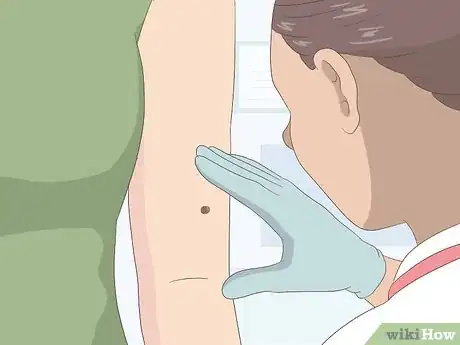



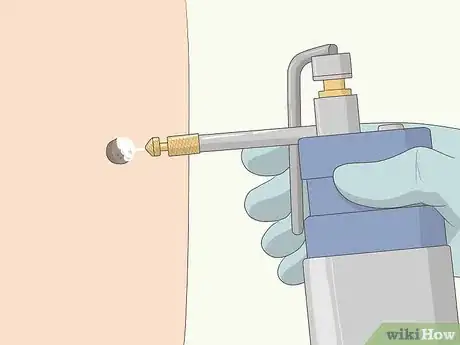


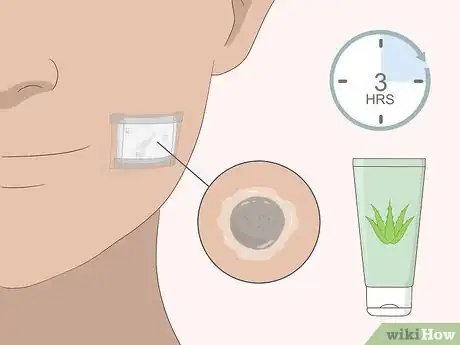


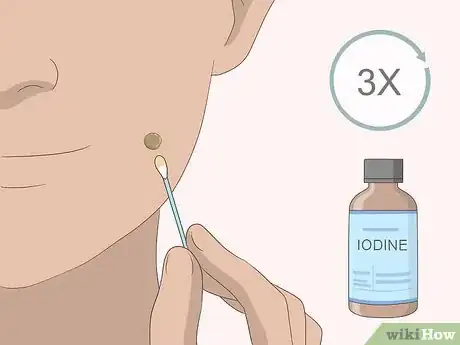




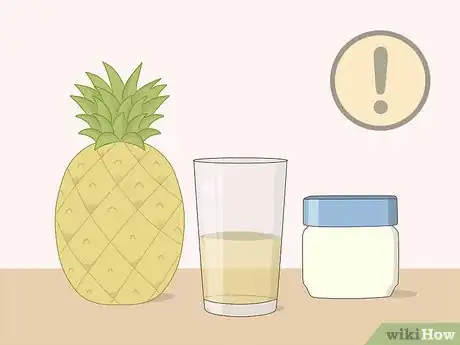




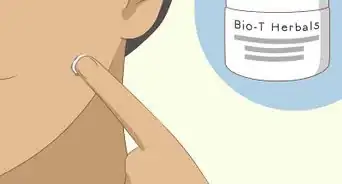


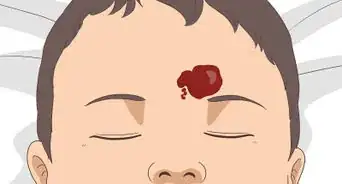


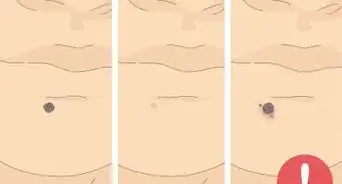



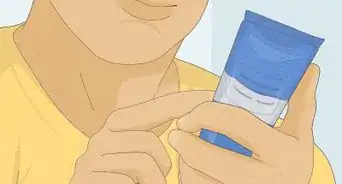













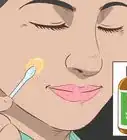



































Medical Disclaimer
The content of this article is not intended to be a substitute for professional medical advice, examination, diagnosis, or treatment. You should always contact your doctor or other qualified healthcare professional before starting, changing, or stopping any kind of health treatment.
Read More...